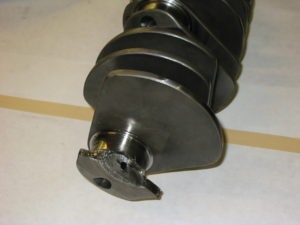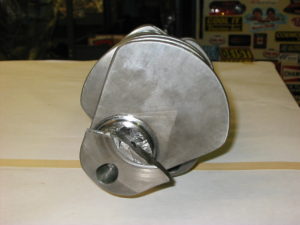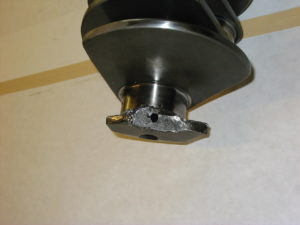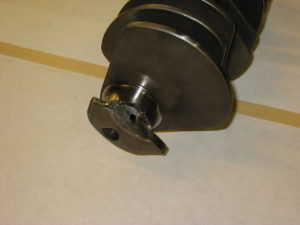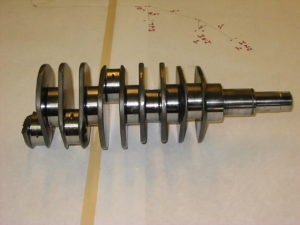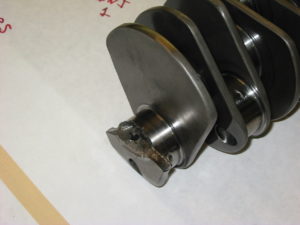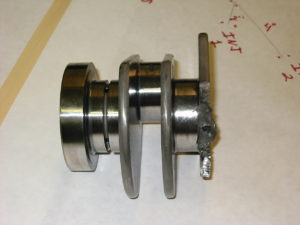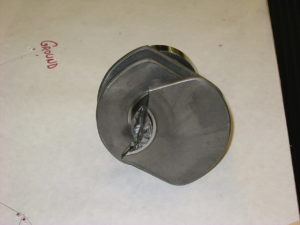Living on the “Knife” Edge
Should I, or should I not? We continue to do things the way we did years ago when we had no reason not to, other than the fact we thought it was a good idea. But, today we have a lot more information to teach us that those assumed good ideas, are just plain wrong. CAD, FEA and CFD to name three computer aided systems we can now use. To narrow this discussion, the Porsche GT3 power train will be discussed. The same can apply for the Turbo power trains.
I see many times on different web sites crankshafts that have had their counterweights “knife edged”. So what is knife edging and what is it supposed to do? It typically narrows the counterweight pendulums at the outer edges and tapers them to a sharp point or an edge like a knife. It’s supposed to cut through the oil in the crankcase with less drag or restriction. Hence, the knife edge part “cutting” a better path. That’s the theory and it’s just that, a theory.
In all actuality it makes zero difference. Any testing performed is typically inaccurate. Dyno reports can show gains, but in closer review the dyno results are subject to inaccuracy by engine RPM, load and other factors. Usually the tests are very inaccurate and have a lot of inconsistencies. We have performed multiple tests on a Spintron machine and proved over and over knife edged cranks add no additional performance to these Porsche engines.
If we were to conduct the same tests on a wet sump Chevrolet engine with very wide counterweights with a much larger radius we might see some gains. However, that is if the oil was stationary, level in the bottom of the oil pan and the counterweights were dragged through this oil mass during the crankshaft rotation. This is not the case, however.
The oil is beaten into foam, aerated and less dense. This now has less of an effect on drag. The oil is pushed away from the crank in the direction of engine rotation and is stacked up against the block and pan inner walls or side. The crankshaft rotates a very all angular amount in this wall. The crank actually spins in no oil for most part. This is in a wet sump engine and not a dry sump.
Porsche engines, for the most part, are supposed to be a dry sump design. The oil is scavenged out of the sump back to an external tank. However, these are not a very good example of dry sump engines. Up until the latest GT3 engines, the crankcase was never in any sort of vacuum and the system was open to atmosphere. This makes the job of scavenging a lot harder and these engines always had positive crankcase pressure. This is why case main webs were tapered and cylinder bottoms were “mooned” to help with internal windage. It is said it made a difference if these mods were performed. I have never seen a difference as most tests were inconclusive and full of inconsistencies. This is also the theory behind the knife edging.
There are inherent dangers associated with removing counterweight mass. Counterweight is exactly that, to counter the weight of the rod and piston weight. In the case of the GT3 and turbo engines, I have seen the counterweights machined away and changed from titanium to steel. This change is usually because of a stroke change and a piston compression height change. In the case of the piston, it’s typically because the pistons are purchased off the shelf ready to use. In many cases, the stock titanium rod could be reused if a new piston was designed with a smaller pin and a shorter compression height. Why it’s not done will be left for you to decide. I believe it has nothing to do with performance and everything to do with cost. Unfortunately, the consequences of running a heavier rod are not understood. When a larger cylinder bore is also incorporated, typically a heavier piston is used. Now it really goes in the tank. Heavier rods and pistons take more mechanical energy to accelerate and maintain piston speed.
I often hear that these flat 6 Boxster engines are naturally balanced. What balance are we talking about? Dynamic or torsional? A big difference. Dynamic balance can be thought of the same as when we balance the crankshaft on a balancing machine prior to assembly. We balance the crank end for end with a measured amount of difference often to zero or 0.5 grams. Porsche cranks are done without bob weights due to the crankshaft design. The crank is rotated at approx. 300 RPM’s and increased upwards to 750 to make sure each end is the same. If the crank is dynamically balanced at 750 rpm, it will be the same as 7000rpm. But this is a crankshaft rotating without compression inputs or what is known as torque pulses. These are the torsional destruction forces that twist the crankshaft back and forth winding it like a spring. Taking mass away from the counter weights has a huge effect on the amount of twist the crankshaft would be placed under. The material the crankshaft is made from and the overlap of the two journals all play an important role in the crankshafts ability to resist twist. So does mass. It takes less force to move or twist a crankshaft with a lower mass.
So why knife edge Porsche crankshafts? I think the answer points to two main reasons. First, the assembler feels good. And second, the customer thinks he is getting something really racy. If you want to feel real racy without compromising your engine, put a number 1 on your door and a racing stripe down the middle of your car. It will be cheaper too.
These images show the destruction forces involved.
This failure to a Porsche 6 cylinder, 74.40mm Crankshaft, is the result of what happens when the engine is run in the harmful RPM range and no dampening device is installed.
With the maximum deflection and twist occurring at the nose of the crankshaft, the failure will typically occur at the Flywheel end. The main bearing will show wear patterns, and these patterns will get progressively more prominent from the rear towards the nose.
